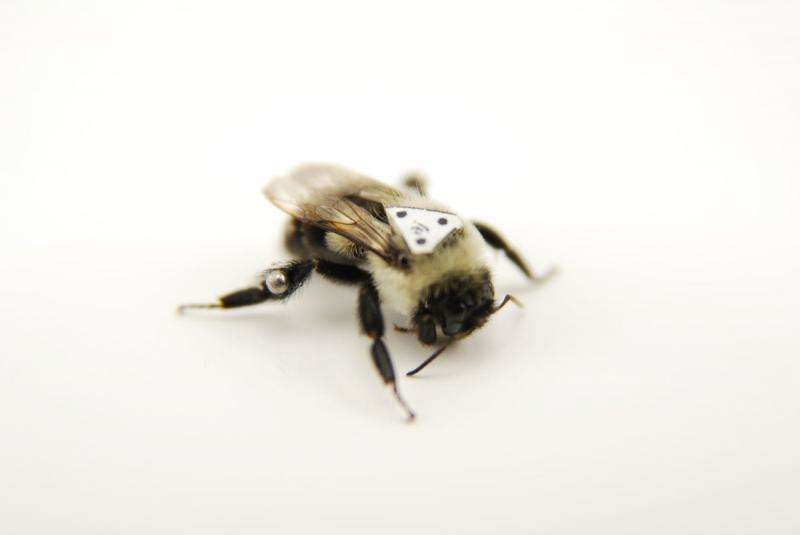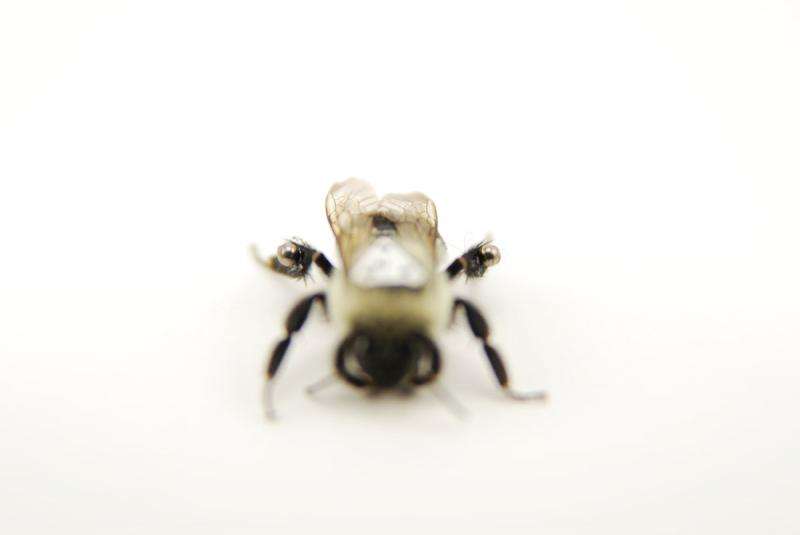A bumblebee with a tracking marker and ball bearings attached to the bee’s legs to simulate pollen loads. Credit: Andrew Mountcastle
(Phys.org)—A trio of researchers, two with Harvard University the other with the Royal Melbourne Institute of Technology has found while conducting experiments, that bumble flight is impacted by the load it carries, particularly pollen. In their paper published in the Proceedings of the National Academy of Sciences, Andrew Mountcastle, Sridhar Ravi, and Stacey Combes describe bee flight experiments they conducted in their lab and what they found in observing the behavior of the bees.
Bees, as most are aware, are pretty good fliers—they are able to keep aloft in various types of weather conditions and do so most often while carrying big loads of pollen or nectar. Pollen, as the researchers note, is carried in the legs, while nectar is carried in a little pouch in the abdomen. Some studies have looked at bee cargo carrying as it relates to survival and reproduction, (they can carry nearly half their weight in pollen and their full weigh in nectar) but none so far have looked at how carrying loads impacts their ability to fly.
To learn more, the team mail ordered a package of bumblebees and put several of them, after affixing differing amounts of stand-ins for pollen or nectar, one by one into a miniature wind tunnel where wind and imitation flower targets were varied. In filming the bees with high speed cameras, the team was able to see how the little fliers adapted to changes in wind speed or to the flower being moved—they found that bee flight was more stable when a bee carried a load of pollen, which helped a lot during windy conditions, though there was a very clear trade-off—all that pollen caused a reduction in maneuverability, an impediment when flying in calm air.
A sample flight trial of a bumblebee with a simulated nectar load tracking an oscillating flower in smooth airflow. Credit: Andrew Mountcastle
The observations suggest, the team reports, that bumblebees might actually choose between fetching pollen or nectar depending on wind conditions. They next plan to study that theory to see if it pans out. If so, that might have an impact on overall colony fitness, they note, a concern as scientists continue to try to find ways to prevent colony collapse with honeybees.
A bumblebee with a tracking marker and ball bearings attached to the bee’s legs to simulate pollen loads. Credit: Andrew Mountcastle
More information: Nectar vs. pollen loading affects the tradeoff between flight stability and maneuverability in bumblebees, Andrew M. Mountcastle, PNAS, DOI: 10.1073/pnas.1506126112
Abstract
Bumblebee foragers spend a significant portion of their lives transporting nectar and pollen, often carrying loads equivalent to more than half their body mass. Whereas nectar is stored in the abdomen near the bee's center of mass, pollen is carried on the hind legs, farther from the center of mass. We examine how load position changes the rotational moment of inertia in bumblebees and whether this affects their flight maneuverability and/or stability. We applied simulated pollen or nectar loads of equal mass to Bombus impatiens bumblebees and examined flight performance in a wind tunnel under three conditions: flight in unsteady flow, tracking an oscillating flower in smooth flow, and flower tracking in unsteady flow. Using an inertial model, we estimated that carrying a load on the legs rather than in the abdomen increases a bee's moment of inertia about the roll and yaw axes but not the pitch axis. Consistent with these predictions, we found that bees carrying a load on their legs displayed slower rotations about their roll and yaw axes, regardless of whether these rotations were driven by external perturbations or self-initiated steering maneuvers. This allowed pollen-loaded bees to maintain a more stable body orientation and higher median flight speed in unsteady flow but reduced their performance when tracking a moving flower, supporting the concept of a tradeoff between stability and maneuverability. These results demonstrate that the types of resources collected by bees affect their flight performance and energetics and suggest that wind conditions may influence resource selection.
Journal information: Proceedings of the National Academy of Sciences
© 2015 Phys.org
























